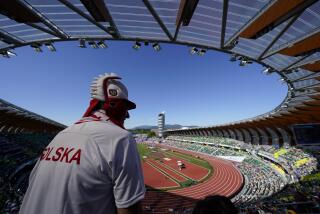Olympic Symbol Goes for the Gold
With Olympic rings, what goes around comes around.
Operators of the Los Angeles Memorial Coliseum proved that Thursday as they rescued the rusty, dented symbols of the 1984 Los Angeles Olympics from a scrap pile and set out to recycle them.
The 30-foot-long set of interlocking Olympic rings will be repaired, equipped with colorful neon lighting and put on permanent, public display near Exposition Park venues used 20 years ago for the Los Angeles Summer Games.
The 2 1/2-ton rings were mounted inside the Coliseum during the ’84 Games. They dramatically came to life during opening ceremonies when gold-medal decathlete Rafer Johnson raced up the peristyle steps and ignited the symbol with the Olympic flame.
In a vivid moment seen on television by much of the world, gas-fed flames circled the five rings before climbing up the peristyle to set the Olympic torch ablaze. The torch burned throughout the Games.
But afterward, the rings were removed to make way for a scoreboard. For a decade they were stored in a tunnel beneath the Coliseum.
The rings were ordered out of the Coliseum by fire inspectors after the 1994 Northridge earthquake. They were relegated to an outdoor storage area in the corner of a Coliseum parking lot at the intersection of Martin Luther King Jr. Boulevard and Menlo Avenue and covered with a tarp.
They were all but forgotten until they were rediscovered by Margaret Farnum, chief administrative officer of the Coliseum Commission.
“We’ve been trying for years to find a way to restore them,” Farnum said as she watched a crane hoist the rings onto a flatbed truck for a ride to the Ampersand Contract Signing Group in Atwater Village.
There, the rings will be repaired and repainted their original gold exterior and black interior colors. Neon lighting will then be installed, glowing in the Olympic rings’ official blue, black, red, yellow and green colors.
The rings themselves were first hand-drawn and colored on a letterhead in 1913 by France’s Pierre de Coubertin, founder of the modern Olympics. They represent the union of the five continents that participate in the Games -- Africa, the Americas, Asia, Europe and Oceania.
The manager of the ring restoration project, David Bentley, said the 15-foot-by-30-foot metal symbol cost $250,000 to produce. The restoration is being done with donated services and $25,000 in contributions from developer Steve Soboroff, the Weingart Foundation and First Federal Bank of California.
“We had to get permission from the Olympic Committee to display them again. They can only be displayed near an Olympic venue. Of course, we’ve had two Games here, 1932 and 1984,” Bentley said.
Two weeks ago the city rededicated the revamped 1932 Olympic Swim Stadium. A $30-million renovation effort -- about $17.5 million of which was paid for with private funds -- repaired earthquake damage to the historic stadium and modernized it.
Stephen Beck, project manager for the seven-year effort, said an addition built over a portion of the stadium’s outdoor seating area now provides space for two full-size indoor basketball courts, fitness workout rooms, a high-tech teen center and kitchen-equipped community rooms. There is also a new off-site child-care center.
Beck said planners had worked with preservationists to blend the concrete stadium with state-of-the-art glass and steel architecture.
So fixing up the Olympic rings will be comparatively easy, he said.
“They’re actually in pretty decent shape. The rings have surface rust and a few dents. They’re going to look great.”
More to Read
Go beyond the scoreboard
Get the latest on L.A.'s teams in the daily Sports Report newsletter.
You may occasionally receive promotional content from the Los Angeles Times.





